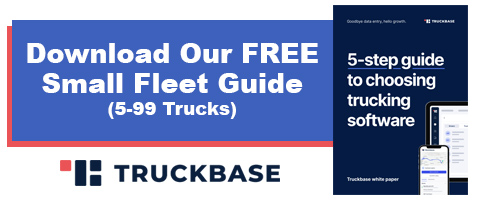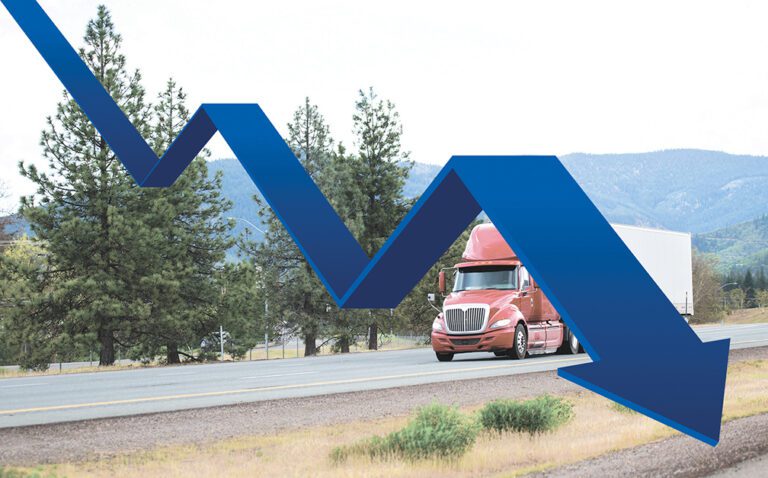More carriers are leaving the marketplace while fewer are starting up, according to July data from the Federal Motor Carrier Safety Administration. New carrier starts (those that received their authority to conduct business) declined by more than 7% during the month, bringing the year-to-date decline to 29%.
According to information received from the Motive Monthly Economics Report, the number of carriers with more than five trucks that left the industry increased from 12% to 17% in July. That means more drivers will be looking for new jobs — including more than 22,000 former drivers at Yellow Corp. At the same time, the U.S. Department of Labor reported there are fewer trucking jobs available.
Motive suggests the rate of contraction will continue for a while longer as carriers continue to close up shop. However, owners of some of those trucks may return to the workforce as company drivers, so the exact impact is hard to measure. While it sounds ominous, market “contraction” actually benefits carriers in the long run — at least the ones that are still operating — because declining numbers of trucks (supply) generally leads to increasing freight rates as competition for available trucks rises.
Increased rates aren’t happening yet, according to the latest DAT Trendlines report. The number of spot loads posted on the DAT loadboard decreased in July by 19.5% from June postings and was down 50.3% from postings in July 2022. Empty truck postings were also down, but by smaller percentages. There are still more available trucks than there is freight, keeping rates depressed.
Average dry van spot rates, according to DAT, declined by 0.7% in July and were 21.8% lower than in July 2022. Refrigerated spot rates also fell — by 2.2% from June and by 18.9% from a year ago. Flatbed rates fell by 2.9% from June and were 22.6% lower than July 2022.
“Spot rates, as a reminder, are ‘all-in’ rates, meaning no separate fuel surcharge to help mitigate the risk of fuel price fluctuations. You have to negotiate each individual load with fuel and operating costs in mind, which is not always easy,” said Ken Adamo, chief of analytics at DAT. “The sudden increase in fuel prices is testing the wherewithal of small carriers at a time when freight volumes are in a seasonal lull.”
DAT’s Truckload Volume Index for July also showed drops. Van loads were down 7% from June and 3% lower year over year. Reefer slipped 3.4% from June but was 1.2% higher year over year, and flatbed dropped 8% from June but rose 3.5% year over year.
“Shippers faced service disruptions at the ports and in the less-than-truckload sector but were able to secure van capacity without causing the needle to move on spot rates and volumes,” Adamosaid.
Despite month-over-month declines, the reefer and flatbed TVI numbers were the highest on record for July as fresh and frozen food, metals, machinery, construction materials and other seasonal freight moved through supply chains, according to DAT.
Cass Information reported that its July Freight Index for Shipments fell 2.2% from June and was 8.9% lower than July 2022. Expenditures were also down, by 2.8% from June levels and 24.4% from last July, an indication that rates continued falling in July.
The Cass report notes that the current “downcycle,” or period of falling freight rates, is now 19 months old. For perspective, the last three downcycles have lasted 21 to 28 months.
In other unfavorable news, the Cass report claimed that private fleets are gaining more of the available freight. In response to reduced freight levels, publicly traded for-hire truckload fleets reduced their tractor count by 3% in the first half of this year, according to Cass. Private fleets represent more than half of Class 8 tractor capacity.
The Cass report also takes a look at new truck production, noting that new truck orders in the next few months will be “very interesting.” If freight levels don’t increase as new trucks continue to hit the market, lower rates will continue.
The Cass Info data includes shipping information from multiple modes of freight transportation, including truck, rail, ship, air and pipeline. About three-quarters of the data is from trucking.
The Motive Big Box Retail Index, which measures trucking visits to warehouses for the top 50 U.S. retailers, showed a decline of 15% for July. “This further supports the idea that the freight recession will remain through the rest of 2023,” the report stated.
The current freight situation — some call it a freight recession — can be summed up by one paragraph heading in the July Uber Freight 2023 Q3 Freight Outlook. The heading reads: “The US consumer remains healthy, but the manufacturing sector continues to contract.” The report notes that retail spending rose by 0.2% in the second quarter and was 1.5% higher than it was a year ago. At the same time, manufacturers’ new orders and inventories remain in contraction territory as destocking continues.
Tim Denoyer, vice president and senior analysts at ACT Research, explained it in a recent ACT blog post.
“The spot market is continuing to rebalance with net revocations still at record rates. Even as the overall market is still on the loose side, the pendulum has started to swing,” he said. “The trajectory of spot rates has changed in the past couple of months, and we think demand fundamentals are likely to improve from here as we pass the worst of the destock. So, more freight market dynamics are in store down the road.”
The overriding message for truckers is that things may not improve any time soon — but they shouldn’t get much worse, either. One publication referred to the current trucking conditions as, “bouncing along the bottom.”
The Motive release has this advice: “Efficiency is king.” Noting that the pandemic, or rather the government’s response to the pandemic, created “highly favorable economics for trucking companies.” Government stimulus checks encouraged spending, creating higher than normal demand for products that needed to be hauled to market. Today, the economy is returning to something closer to normal. Inventories have been adjusted to pre-pandemic levels.
Carriers that survive the current period of lowered freight rates and more competition for loads will do so because they are able to operate efficiently and conserve cash. Small carriers with no business plan and an “operate as usual” attitude will be swept away by the tide of tough trucking conditions.

Truckbase simplifies the logistics management process, increases efficiency and provides peace of mind.
Cliff Abbott is an experienced commercial vehicle driver and owner-operator who still holds a CDL in his home state of Alabama. In nearly 40 years in trucking, he’s been an instructor and trainer and has managed safety and recruiting operations for several carriers. Having never lost his love of the road, Cliff has written a book and hundreds of songs and has been writing for The Trucker for more than a decade.








